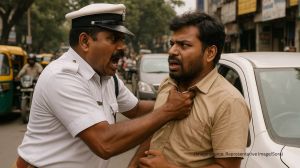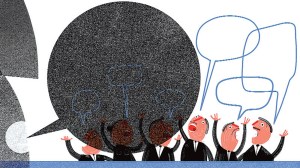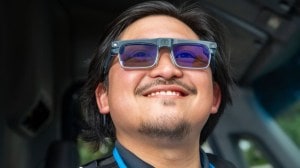Stay updated with the latest - Click here to follow us on Instagram
From deadly Japanese quake to Covid pandemic, ‘wind phones’ help the grieving connect to loved ones they lost
First created by garden designer Itaru Sasaki in 2010 to help him cope with his cousin's death, the wind phone was opened to the public the following year after the 2011 Tōhoku earthquake killed over 15,000 people in Japan.
 The wind phone in Ōtsuchi, Japan was built after a devastating earthquake in 2011. (Source: Wikimedia Commons)
The wind phone in Ōtsuchi, Japan was built after a devastating earthquake in 2011. (Source: Wikimedia Commons)“I’m so glad we met, thank you, we’re all doing what we can, talk soon,” Kazuyoshi Sasaki speaks into an unconnected phone in Japani’s Otsuchi, addressing his departed wife.
In 2010, garden designer Itaru Sasaki built a phone booth in his garden in Otsuchi, a town 500 km northeast of Tokyo, after he lost his cousin to cancer. “Because my thoughts couldn’t be relayed over a regular phone line…,” Sasaki told Japanese TV channel NHK Sendai, “I wanted them to be carried on the wind.”
In March 2011, an earthquake struck Tohuku, killing nearly 20,000 people and Sasaki’s phone booth soon transformed into a way to process loss and a way for many survivors to connect with their loved ones for whom they could not grieve in the traditional manner. “It is believed that 10,000 visitors journeyed to this hilltop outside Ōtsuchi within three years of the disaster,” says the Atlas Obscura website.
Kaze no Denwa, or the phone in the wind, receives no incoming calls. Amid sobs and tears, people speak of pain, despair, frustration, regret, finding strength and the meaning of life without a loved one.
As of today, the world has at least 61 wind phones, according to http://www.mywindphone.com. These are across the US, Canada, Europe, Asia, Australia, New Zealand and the UK.
The latest one to come up is in Quebec, Canada. Josée Chartrand agreed that a wooded area that was an oasis for her late husband, whom she lost to Covid-19, could become a spot for a wind phone. And with the community’s help and contributions, it did. Donna Troop, a volunteer at the Bereaved Families of Ontario organisation, who approached Chartrand with the idea, told CBC that the Le fil du vent Chelsea Wind Phone offers its visitors “permission to be exactly where you are with your grief,” away from societal pressures, to move on.
A series of wind phones came up over time in cities, rural belts, scenic locations and sparsely populated pockets, serving as therapists for hundreds in their vicinity.
Oakland in California got a wind phone in 2017 while, across the Pacific, a ‘phone of the sea breeze’ was built in Japan’s Tahara in 2018 by Kazuko Kutsuna, who lost an 18-year-old student to suicide. When 36 people died in a Ghost Ship warehouse fire, North Carolina got one in 2021. An on-site sign at the phone on the Gentleman’s Ridge side of the scenic Aspen Mountain reads: “On the wings of belief and love, your words will be carried through the trees and on the wind to wherever you want them to go.”
At a time the first two waves of the Covid-19 pandemic had already left a shocking trail of deaths and people battled the uncertainty of the new Omicron variant, a new phone on the Appalachian Trail (AT) in New York proved to be a godsend. A similar one in Canada’s British Columbia helped offer a place of mourning to many during the pandemic and the province’s overdose crisis in 2020.
A CBC report recounts Brooke Robichaud telling her departed younger brother at the phone at Port Moody’s Pioneer Memorial Park, “I’ll do everything I can to share your life, your story, and how amazing you are. You still are. I can feel you around here.” Robichaud, whose brother died of overdose at the age of 23, is convinced that he is listening when she says into the phone, “I think your story is going to save a lot of lives.”
It is not just the number of phones or the sheer number of visitors that prove the connection that this unconnected phone has formed with the grieving. Painted shells, poems and notes adorn the Goosefields Wind Phone in Portsmouth, Rhode Island. Emsellem-Wichowski, who set up the phone booth in August 2021, says, “People are like, ‘I lost my sister in an accident last year, and doing this was important to me.’ Another remarked, ‘I’m a sad person, but this made me smile.’ Yesterday evening, my husband and I were going for a walk, and a lady pulled over… and she said, ‘Thank you so much. I lost my son, and I’ve gone there to talk to him.’”
In Illinois too, the wind phone booth in Marshall has a collection of artefacts left by visitors – windchimes, rocks, plaques, flowers, flags, even ashes of loved ones.
Does it make sense to dial and speak on a phone that is connected to nothing? Photographer and amateur carpenter Corey Dembeck, who installed the phone at the Priest Point Park in Washington told CBS News, “I don’t think I got, really got, how many people really needed something like this.”
Erin Sylvester, who lost her four-year-old daughter to an infection, emphasises the need to express grief for healing to begin. “I think one of the most dangerous things that you can do to yourself is to keep your feelings, whatever they are, locked up inside,” she says.
What Sasaki built was a white, glass-paned telephone booth containing a black, disconnected rotary dial telephone placed on a metal shelf. What it has become today is a mechanism for grieving so strong that it has touched possibly millions across the world, besides inspiring a book, articles and even a movie.
Sasaki published a book on his experiences involving the phone six years after the earthquake struck Otsuchi. The wind phone also featured in the Netflix docuseries Earthstorm, while NHK released an Emmy-nominated documentary The Phone of the Wind: Whispers to Lost Families. The films documents teenager Ren Kozaki travelling alone for four hours to talk to his departed father, a truck driver who was on a newly assigned route when the tsunami hit. “Hey, dad. Are you doing okay? We’re doing the best we can, so don’t you worry. Why did you have to die? Why can’t we find you?” he asks.
A decade after the tsunami swept away Tochiro, her husband of 44 years, Sachiko Okawa broke down on the phone in Otsuchi. “I’m lonely” she said, in a scene witnessed by a Reuters reporter. Huddled in the phone booth with her is her 12-year-old grandson, who said, “Grandpa, it’s been 10 years already and I’m going to be in middle school soon. There’s this new virus that’s killing lots of people.”
Recalling the frantic search for his wife days after the 2011 earthquake and tsunami, Sasaki says to no one at the other end, “It all happened in an instant, I can’t forget it even now. I sent you a message telling you where I was, but you didn’t check it.” “I’ll take care of myself,” Sasaki reassures his late wife.
Twelve years since the first wind phone was built, the grieving continue to turn to the phone to cope with the void left behind by those who are no longer among them. A poem on the wind phone in Sherod Park, Ohio rightly says, “In life we loved them dearly; in death we love them still. Our hearts hold a place no one can ever fill.”



- 01
- 02
- 03
- 04
- 05




























